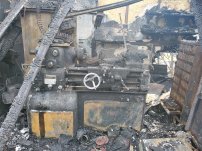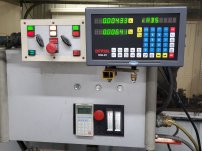1. Should I be looking at AC or DC servos?
2. Any particular brand?
3. What size motor? Servos seem to be rated by watts and not the hp I am use to.
4. How do I control the rpm?
5. Anything else I should know?
I'm a huge proponent of servo drives. I think they're the absolutely best alternative to the original Monarch DC drives, and in some ways exceed the performance of the original drive. For instance, the Monarch drive was designed to stop within 2 seconds, the my servo drive with stop within 2 turns at moderate speeds/masses. For my 69 modular, I'm using a Mitsubishi MR-H series 3.5kW AC servo drive and motor which is just under 5 hp (kW=HP x 0.746). I also incorporated the back gear box as the HP is slightly under the original and Monarch felt it was necessary at 5HP and is more than enough for anything I'd ever be doing on a 10EE. But incorporating it does add a level of complexity to the build that many folks don't feel is worth the effort and may opt for a larger motor instead. It's a bit easier to adapt to older machines that use a simple keyway on the motor shaft to drive the back gear because newer machines use a splined shaft making it more difficult to make in the average home shop. Since my motor was destroyed in the fire I was able to cut off the front splined section of the shaft and adapt it to the servo motor.
I think all modern stuff is AC, I don't see any DC servo's on CNC machining centers these days. We've got a couple of old Mori Seiki SL series lathes from the 80's that have yellow cap Fanuc DC motors on them, scrapped everything else that had them years ago. I'd stick with modern AC stuff personally.
One key motor aspect you need to consider besides HP is max. RPM. Many of the servo motors I looked at were 2000 RPM, it was also the standard RPM on the MR-H series motors. There was a 3000 RPM option, but they were very rare taking me a couple of years to come up with one I could actually afford on FleaBay. BTW, beware that there's now a FLOOD of Chinese counterfeit MR-H 3000 RPM motors flooding Fleabay, they aren't genuine Mitsubishi's. My 10EE was a 4K machine so 3K isn't ideal, but I really don't do any high speed work therefore a non-issue for me.
Control is another important consideration. You have to determine what methods of control a particular drive is capable of. Some control options are software, 0-10 vdc, 4-20ma, step/direction, quadrature, and others. All the CNC machines I work on use software control where the CNC gives the drive instructions over a serial or optical port. Fanuc, Mitsubishi, Siemens, Toshiba, all use their proprietary software to control the drives directly and therefore aren't suitable for conversions. You need what Mitsubishi called their general purpose version (I think it's a -B, the -A was the serial) which had provisions for 0-10v, step/direction, quadrature, and fixed steps, other manufacture's may call it something different. You have to get a copy of the manual for any drive you might be considering using and look up the specific model drive you have to determine how it can be controlled. To use 0-10v you simply connect a 5-10K typ. pot to 3 terminals on the drive and instant dial-a-speed. Pretty much the same as hooking up a VFD, power in, motor out, speed pot, direction switch, and Stop/Go switch for basic operation so pretty easy. I got a bit fancier and incorporated separate forward and reverse speed pots. There is one complication with servo's, when you stop the machine the servo is still going to be trying to maintain it's position and you won't be able to rotate the spindle by hand. To get around this, I used a time-delay relay to shut-off the servo drive 2 seconds after the spindle is stopped.
The drive I used also had a pair of axis over-travel limit switch inputs. I connected proximity switches to these which will stop the drive if either is turned ON. They are on both sides of the carriage on the ELSR rod so I can take advantage of the nice fine adjust mechanism to fine tune the stopping point. At moderate speeds/mass it stops reliably in <0.002" with the standard prox. switches I'm using. It's a TRUE Electronic Lead Screw Reverse system and can easily be adapted to non-ELSR machines. High precision versions would reduce the error window but it's plenty good enough for me as is. I also incorporated the original ELSR system into the servo system and it still functions perfectly.
This is where the brand comes in. There are a lot of Chinese no-name servo drive/motor combinations on FleaBay at very attractive prices. I purchased one to power my Bridgeport style mill that was burned up in the fire along with the Monarch. I discovered that they are very basic, and offer virtually no features other than the basic run/stop/direction/speed/E-stop. No inputs to turn the servo control On/Off, no limit switch inputs, etc. so things like the spindle turning off after a bit aren't straight forward to incorporate. OK for the mill, but not for the lathe. FWIW, I had the same experience with the cheap Chinese VFD's, they pretty much just spin the motor. There's also the long term reliability of motor and electronics. All the brand name drives manufacturer's use nothing but top of the line components. You're not going to open up a Fanuc drive and find Jackcon capacitors. OTOH, feel lucky if you get that good of a capacitor in a cheap Chinese drive. Something else folks often overlook is the quality of the manual. The manuals for both the Chinese servo drive and VFD were awful, on the verge of being worthless while brand name manuals tend to be very detailed and comprehensive and much easier to understand. Figuring out how to properly set the drive parameters (servo or VFD) is often the hardest part of all and when the manual sucks, it makes it an unnecessarily long, frustrating process. That's another major difference, the cheap drives have pretty limited parameters, often just a fraction of the brand name drives. While it may make programming a bit easier, it severely limits the versatility of the drive. Like most things in life, you get what you pay for.
Well that's enough rambling for me, spent all night chipping burnt paint/crap off my poor Monarch, I'm heading to bed. Here's a pic of it after the fire to give you an idea of the utter devastation. Luckily I had the control box I built with the servo drive and controls in the second picture at my new house already at the time of the fire so escaped a fiery death.
Marc --



